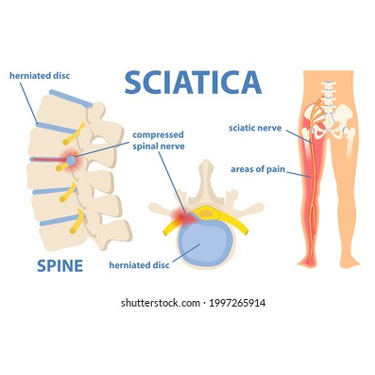To understand what triggers sciatic nerve pain there are three groups of things to consider. One is spinal, one is non-spinal and the third is iatrogenic or medical. To fully understand the discussion, we will cover a little bit of anatomy. So the sciatic nerve, basically the brain extends down into the body as the spinal cord through the armored tube that we call the spine. And at the bottom two levels of the spine two nerves come out, as well as three nerves from the tailbone, and they blend together and they make a large nerve that’s about the width of your little finger. And that goes from within the pelvic bone, it actually exits out of the back of the pelvic bone and then travels down the rear of the leg it then splits into two and goes to the foot and muscles in the back of the leg. That nerve is called the sciatic nerve.
Bony armoured tube commonly called the spine, so if you look at the base of the spine you have spinal bones that support the weight of the body and in between each bone there is a disc. The disc is actually a spacer. It’s filled with fluid. It’s not designed to support a lot of weight. The curves in the spine make a spring; they are designed to support a lot of weight. But if we go to the back of the spacer there’s a hole and out of the hole, if you can see it, there’s a yellow bundle in this case it’s cut short. But in most cases, it will continue out, in fact, not in most cases in all cases it’ll continue out.
In the case of the sciatic nerve these nerves come out, they join together they come through this hole at the back and then down the leg now if there is a restriction or an interference in the nerve system around here there can now be faulty signals going to the muscles. That means that the muscles can go into spasm and start to hold the structure in a weird and wonderful way. Obviously, we still carry on through life but over a period the disc starts to flatten. As the disc flattened because it doesn’t have the motion it should have. This in turn closes the size of that hole and in turn we start to get pressure on the nerves. Now with the sciatic nerve because it’s so long there are various areas that can be compressed. As a chiropractor I look to remove restrictions on the nerve system, interference on the nervous system to get that area moving correctly.
Three Main Causes
So for me nerve interference is one of the triggers which actually runs through all three groups I mentioned earlier. There are basically three main spinal causes, the first one I’ve just discussed – there could be nerve interference called a subluxation in chiro speak.
The second can be what’s called stenosis. This can often be because of the spine not moving properly. Stenosis just means narrowing so there are two places that the channel in the spine can narrow. One is in the hole as the nerve comes out of the spine and the other is actually within the spine. There is a hole all the way through the spine. Now narrowing happens for a lot of different reasons one of them is restricted motion but there could be other reasons as well. The second is something called spondylolisthesis. Again, this is a fancy name and what it basically means is that this vertebral bone is moving forward instead of being in the place it’s meant to. It’s moved forward and if you imagine the cord running down through the hole in the rear of the spinal bone as that bone moves forward it’s going to put pressure on that cord. So that is spondylolisthesis, or we could call it vertebral slip…forward vertebral slip. This can cause pressure on the nerves and in turn if it’s down here it can start to stretch nerves within the spine which in turn can cause irritation and cause a trigger to the sciatic nerve pain.

And then and the third reason is lumbar radiculopathy which is where the nerves coming out of the lumbar spine are affected in a disease state so that the nerves start to break down again, some people say that subluxation or restriction of motion can lead to that sort of problem. Non-spinal causes of sciatic nerve pain include things like piriformis muscle spasms. The piriformis is a muscle that crosses the inside of the pelvis, it also crosses the sciatic nerve so if it goes into spasm and can put pressure on the sciatic nerve. At the end of this video there will be another video which gives you the four best sciatic nerve pain release stretches and that’s the muscle that’s actually being released.
Pregnancy
So, another non-spinal cause is pregnancy. During pregnancy the ligaments tighten up and the joints of the pelvis become very flexible. Obviously in preparation for the birth of baby, so that can lead to interference with the sciatic nerve. That’s why a lot of pregnant moms either get sciatica or in some cases after they’ve had sciatica for years it can go away when they’re pregnant, because these joints reposition themselves. And if you have trauma to the leg that, of course, could cause interference with the sciatic nerve. And then finally pelvic or sciatic nerve tumors can cause sciatic nerve pain and trigger sciatic nerve pain. So that’s for non-spinal causes and then the last group of causes we talked about was iatrogenic or medical based causes of sciatic nerve pain. And these sorts of things can be intramuscular injection.
